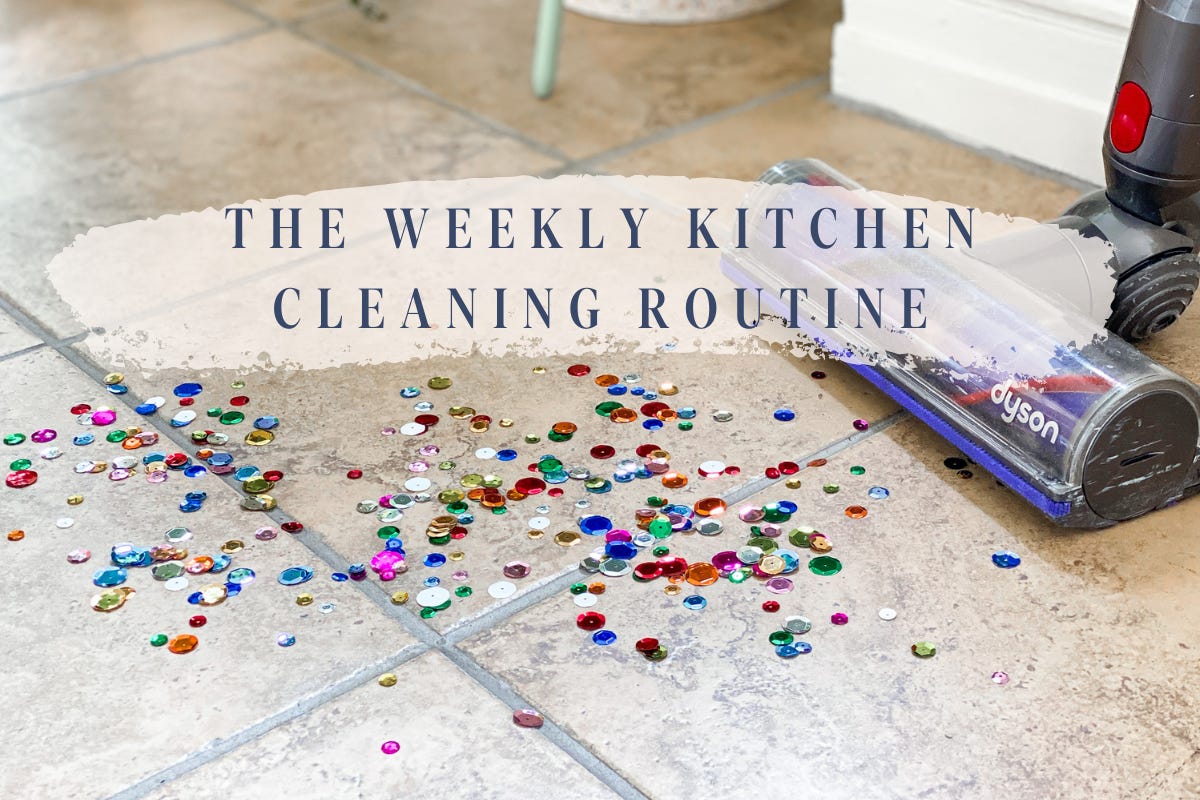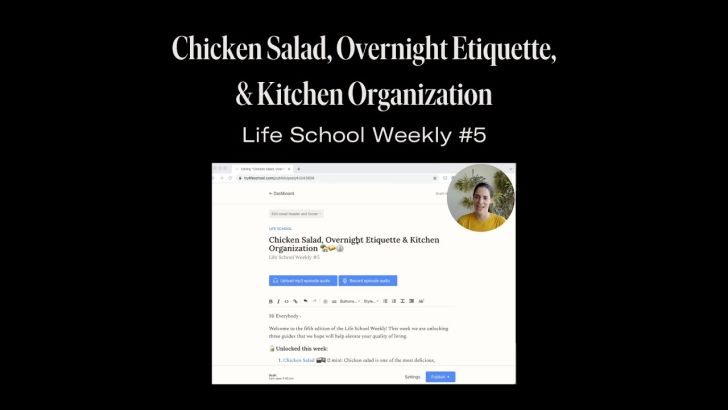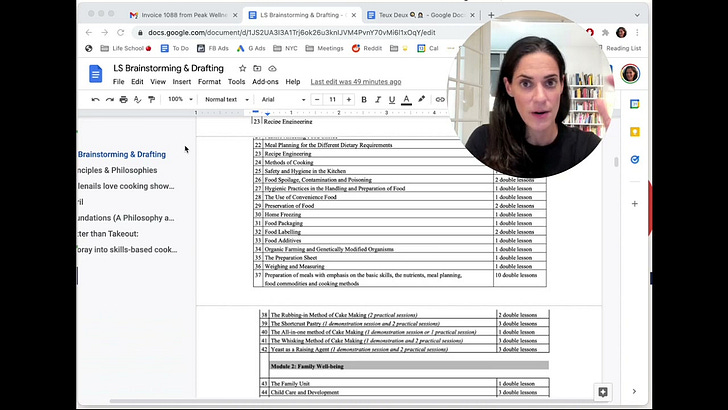This lesson is 777 words, a 3 min and 5 second read time. It is the first lesson of The Weekly Kitchen Cleaning Routine.
📍Introduction:
Like a weekly face mask or steam at the gym, a deep kitchen clean can feel oh so satisfying. By tackling more challenging cleaning activities once a week, they become an integrated part of your self/home-care routine. This regularity will help reduce buildup and ensure that your workspace performs at its best. Working in a sparkling kitchen is more pleasant, comfortable, and relaxing.
The weekly routine builds on what we covered in The Daily Kitchen Cleaning Routine. It focuses on the deeper levels of cleaning, covering techniques & hacks to deal with tougher messes (e.g., sticky floors, oily fingerprints, and smelly sinks.)
In this course, we have structured the heftier cleaning duties into a few discrete tasks. They are: wiping appliances & cleaning the stovetop, tidying the fridge & emptying the trash, vacuuming & mopping the floors, cleaning & disinfecting the sink, laundering kitchen towels, and caring for tools. Let's dive in.
⚙️Required Gear:
Vacuum (highly recommended, or broom/dustpan)
Mop (spray or traditional) & floor cleaner (optional)
Cleaning cloths (e.g., microfiber, terry bar mop towels)
All-purpose spray
Abrasive powder (e.g., baking soda)
Abrasive sponge
Laundry detergent
🛒 Product Recommendations:
*Note - additional gear can be found in the Daily Kitchen Cleaning Routine
Mop: Spray/pad for wooden floors: ($), Spin mop for stone/tile: ($)
Bar mops/rags: can repurpose old towels & tees or buy inexpensive matching ($)
All-purpose cleaner: natural recommended ($$)
Abrasive powder: Baking soda or Bar Keepers friend ($)
🔢 The Weekly Kitchen Cleaning Routine
(More detail in following lessons)
Wipe down stovetop & appliances.
Clean out & tidy the fridge. Empty trash & recycling.
Vacuum the floors & if necessary, mop.
Rinse & disinfect the sink.
Launder cleaning towels.
Care for tools (as needed).
📝 Notes, Tips & Tricks:
Done all at once, these tasks will take ~20-30 minutes. Alternatively, you can break them up throughout the week into micro-cleans at ~ 10-15 min each.
If done weekly, this routine prevents the buildup of dust and grime. It does not, however, guarantee a spotless kitchen at all times.
For a "next-level" clean kitchen, we recommend the following activities every ~3 days, or as needed: (1) clean stovetop, (2) disinfect sink (3) vacuum.
A cordless vacuum stored near the kitchen can do wonders for those who love to cook in their bare feet.
Kitchen cleaning can be a great background activity for other things (e.g., podcasts, thinking time, music, talking on the phone). It is also great for getting the body moving and blood flowing (especially emptying the dishwasher & mopping the floors 🕺).
A kitchen timer or clock can help you get a sense of how long things take. Try setting it for 10 minutes and racing to "beat the clock" with a given activity. You might surprise yourself with how little time most activities take.
Individual cleaning tasks make for great desk/screen-time breaks.
Kitchen cleaning products are ideally stored together in the kitchen (e.g., in a bin or bucket under the sink or inside a cupboard nearby)
📓Kitchen Cleaners Reference Guide
Cleaning fluids range in pH from 0 (acidic) to 14 (alkaline). 7 (dish soap) is neutral. Alkaline cuts through dirt, grease, proteins, oils, and other organic items. Acids are better for calcium, rust, and other minerals.
Chlorine Bleach: pH level 11-13 (highly alkaline); corrosive and requires ventilation, not safe on many surfaces and can bleach fabrics; great at whitening and removing stains
Ammonia: pH 12; also corrosive and requires ventilation, don't mix with other ingredients (creates harmful gasses); works wonders on tough dirt and grime.
Oven Cleaner: pH 11 to 13: similar to ammonia
Borax: 10, breaks down oils and organic dirt, effective as a laundry booster
Baking Soda: pH 8 to 9: just barely alkaline, can cut through grease and dirt but not strong enough to be corrosive, great for many areas of the home b/c less toxic.
Mild Dish Soap: 7-8: neutral cleanser, if it's labeled "mild," "gentle" or "great for hands," chances are it's neutral; great for everyday cleaning, not damaging for surfaces, can be used many places other than kitchen sink (e.g., cleaning stovetop, floors); cuts through grease
Stone Cleaner: pH 7 to 10; 7 recommended for natural floors, marble, etc.
Vinegar: pH 3 - acidic - great for removing mineral deposits but can also damage some surfaces (e.g., stone)
Lemon Juice: pH 3, acidic - great for cleaning copper pots and drains but careful on stone or near grout
🎓 Further Study:
The Daily Kitchen Cleaning Routine [Life School]
How to Clean Everything in your Kitchen!🎬 [YouTube]
—
🎧 Prefer to listen? Subscribe on iTunes, Spotify, or Overcast.
🗣 Discussion topic: Do you have a favorite weekly kitchen cleaning task or hack? Let us know in the comments below. 👇











